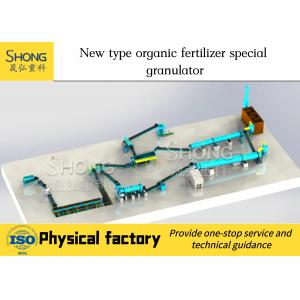

Add to Cart
Automatic Food Waste Organic Fertilizer Treatment Production Line
Product Description
Food waste, also known as drowning water, food residues, food and
kitchen residues, etc. Now people's awareness of environmental
protection has increased. The disposal of food waste has always
been a concern for people. The content of organic matter in food
waste is high, about more than 95% of dry matter. It is easy to
corrupt and stink, and breed bacteria, causing the disease to
spread. Especially in the summer, secondary pollution can easily
occur during collection and transportation. However, in addition to
the high content of organic matter in food and kitchen waste, it is
also rich in protein, nitrogen, phosphorus, potassium, calcium, and
various trace elements. It has the characteristics of complete
nutrition elements and high recycling value. Jiutian Company's use
of food waste as a comprehensive utilization of resources not only
avoids resource waste but also makes the resources reused and turns
waste into treasure.
There are three main paths for comprehensive utilization of kitchen
waste resources. The first is protein feed made from kitchen waste.
The kitchen waste is sorted, removes impurities, crushes,
dehydrates, deoils, recovers oil, produces biomass diesel, and then
adds yeast, probiotics and auxiliary materials, undergoes aerobic
fermentation, drying, cooling, packaging, and waste water and waste
gas pass through. The final products are protein feed and biomass
diesel after treatment of up-to-standard emissions; the second is
organic fertilizer made from kitchen waste. The kitchen waste is
sorted, removes impurities, crushes, dehydrates, deoils, recovers
oil, produces biomass diesel, and then adds yeast, enzyme
preparations and auxiliary materials, undergoes aerobic
fermentation, drying, cooling, packaging, and waste water and waste
gas pass through The final products are organic fertilizer and
biomass diesel; the third is to make biogas from kitchen waste. The
kitchen waste is sorted to remove impurities, pulverize, deoil,
recover oil, and then add anaerobic bacteria material. In a sealed
tank, anaerobic fermentation is performed to produce biogas, which
is used for power generation or combustion. The waste residue is
dehydrated, Organic fertilizers are produced by drying, cooling and
packaging. The wastewater is treated and discharged up to the
standard. The final products are biogas, organic fertilizers and
biomass diesel.
Project Feature
(1) Food waste treatment equipment innovation: The process of food
waste to regenerate protein feed, regenerating fats, fermented
biological feed, and organic fertilizer, which is based on the
economic value of food waste. In the same production line, through
the physical, Comprehensive technical classification, extraction
and processing of machinery, biology, and other products with
different economic values such as protein feeds, oils and fats,
fermented biological feeds, biogas, and organic fertilizers, which
is high economic efficiency, using the new ideas and processes of
food waste to developing the new resources.
(2) Kitchen waste treatment equipment innovation: There are many
sundries in the food waste, the components are complex and
unstable, and the oil content is high. Therefore, the key equipment
in the complete set of equipment is the special equipment after the
innovation and transformation. The complete set of equipment is
fully sealed and automatically system and the central program
control system. It realizes the continuous, automated, and
large-scale reprocessing and utilization of food waste.
(3) Renewed product innovation: The food and kitchen waste need to
classification and extraction, and the simultaneous production of
protein feeds, oils, fermented biological feeds, fermented organic
fertilizers, biogas, etc. Now it is international mainstream. The
protein content is 32-37% in renewable protein feed. Regenerative
fat is a chemical raw material. Regeneration of fermented
biological feed is made by changing the feed filling material to
make various new types of feed, regenerating fermented organic
fertilizer, nitrogen, phosphorus and potassium, and rich in plant
nutritive elements. Anaerobic fermentation to produce the biogas, a
full-depth use of food waste nutrients, this kitchen waste
resources can be 100% recycling.
Working Principle
Material Flow: the raw material with 75-85% moisture will be sent
into the dewatering machine, and then the moisture will be reduced
to 60-65%, then feed into the dryer by screw conveyor, concurrent
flow drying. Under the effect of the inner shoveling plate,
materials are taken and scattered constantly, and move in the
spiral forward method. Through three layers (inner, middle, and
outer layer), heat exchange is realized between material and hot
air medium. The materials that achieve the drying effect move
forward fast and are discharged out of the roller. Wet materials
that still don't achieve the drying effect couldn't move fast due
to self-weight and are dried completely during the controlling
route, thus achieving the drying effect. After the whole drying
process is completed, materials are discharged by a screw conveyor.
The final moisture will be reduced to 14-18% (can be adjusted
according to the buyer's requirement). there is a special device
inside the dryer, that can prevent the unequal drying of materials.
Air Flow: through the hot blast stove and air blower inflating, the
air enters the hot blast stove for combustion heating. Its
temperature reaches up to 600-850ºC, then it is inhaled by the
dryer-induced draft fan to dry material and evaporate water. When
the temperature decreases to 55-60ºC, it is discharged out of the
dryer. Wet air containing dust is discharged on standard through
dust remover purifying.
